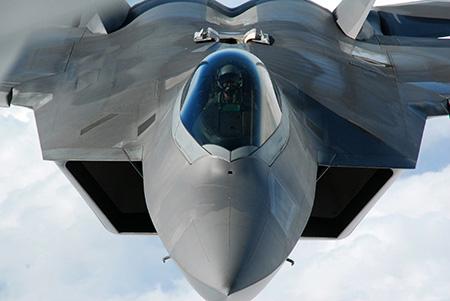The Pentagon has issued data on the sorties carried out by the Raptor over the skies of Iraq and Syria.
It is, of course, not a novelty, that the contribution of the fifth generation hunt was mostly restricted to the stock, with its powerful software apparatus serving the other coalition aircraft to which "dirty work" is called.
"In almost ten months of activity against the Islamic State, the American F-22s have carried out 204 sorties, attacking 60 positions and throwing 270 bombs". Totally negligible numbers when compared to the planes of the US-led coalition, which in the same period carried out 44 sorties and attacked 7900 enemy positions.
They say from Air Force to the Associated Press. "The role of F-22 is decisive. Its sensors contribute to protecting the entire fleet and are crucial to discovering enemies beyond the visual range, although it is apparent that the Raptor was not designed for counter-insurrectional roles. "
b.jpg) How to blame the Air Force. The F-22 has been designed to excel in extreme air-to-air combat situations, thanks to its air defense systems and stealth profile. Superlative skills that earned him the title of "aerial domain" fighter.
How to blame the Air Force. The F-22 has been designed to excel in extreme air-to-air combat situations, thanks to its air defense systems and stealth profile. Superlative skills that earned him the title of "aerial domain" fighter.
It would be fair to note, however, that the sky in Iraq does not represent an environment with a high level of threat. In short: even the F-15 could have performed (and is doing) this role, without the need to deploy the small Raptor available. Instead, there is a different speech for the Syrian skies, where the government has not authorized US-led raids.
Syria is held in possession of some advanced (purchased by the Russian) air defense systems that only the Raptors could identify and eliminate before any other fourth-generation allied fighter deployed. The F-22, on a standard mission against ISIS, only escort the F-16, guiding them to targets and minimizing collateral damage.
It seems obvious: the USA regrets the moment when they decided to close the Raptor line. A choice, with the benefit of hindsight, considered to be totally wrong and based on a caducous world tranquility. Of course, since his entry into service the Raptor has never faced a Russian or Chinese fighter, but having closed the production of the F-22 is now considered the biggest mistake in the history of the Pentagon.
Plagued by numerous design problems, such as when the entire fleet was grounded due to a problem of vertigo felt by the pilots in the 2011 (it turns out to be a faulty valve in the drivers' jackets), the Raptor evolved into the best hunt of the world. His abilities are enormously expensive: the last fighter from the Marietta plant in Georgia has cost US taxpayers 190 millions of dollars. To date, the entire Raptor program has exceeded 67 billion dollars.
.jpg) Designed to be the heir of the F-15 and to equip the units with no less than 400 aircraft, and due to budget cuts, the number has then been reduced to 187 specimens with the closing of the flight line. Yet what would it have been if it happened in September of the 2006, the United States Congress had unanimously voted for a ban on selling the Raptor to any country in the world, thus sanctioning the end of the program.
Designed to be the heir of the F-15 and to equip the units with no less than 400 aircraft, and due to budget cuts, the number has then been reduced to 187 specimens with the closing of the flight line. Yet what would it have been if it happened in September of the 2006, the United States Congress had unanimously voted for a ban on selling the Raptor to any country in the world, thus sanctioning the end of the program.
Many countries, like Israel, Japan and Australia, for example, had no choice and opted for the F-35 (by some considered at the time "the low-cost version of the Raptor").
The F-22 Raptor has been designed for 8000 flight hours with a cell resistance designed for thirty years. It will be replaced in the 2030 by a sixth-generation platform. Considering that the US Navy has already said that the F-35 will be the last fighter with human on board, in a few years the Air Force could deploy its UAV fighter.
Although there is no confirmation, the sixth generation hunting prototype (we already know the specifications) could already skip the skies in some secret American base. If that were not the case, the development of the sixth generation hunt would be delayed.
Franco Iacch
.jpg)
(photo: US DoD)












